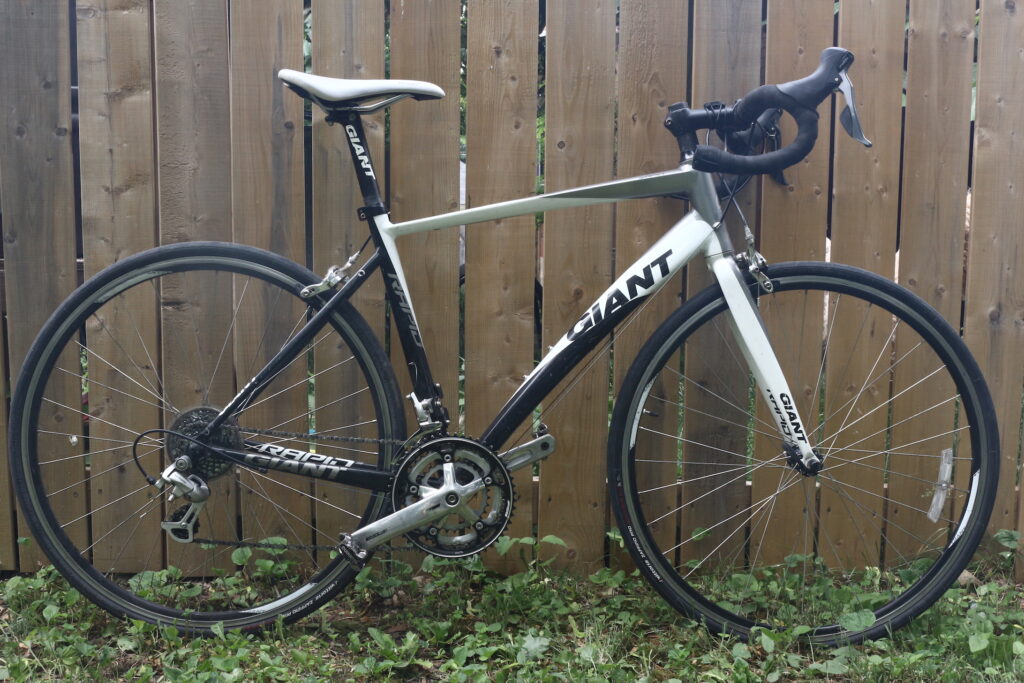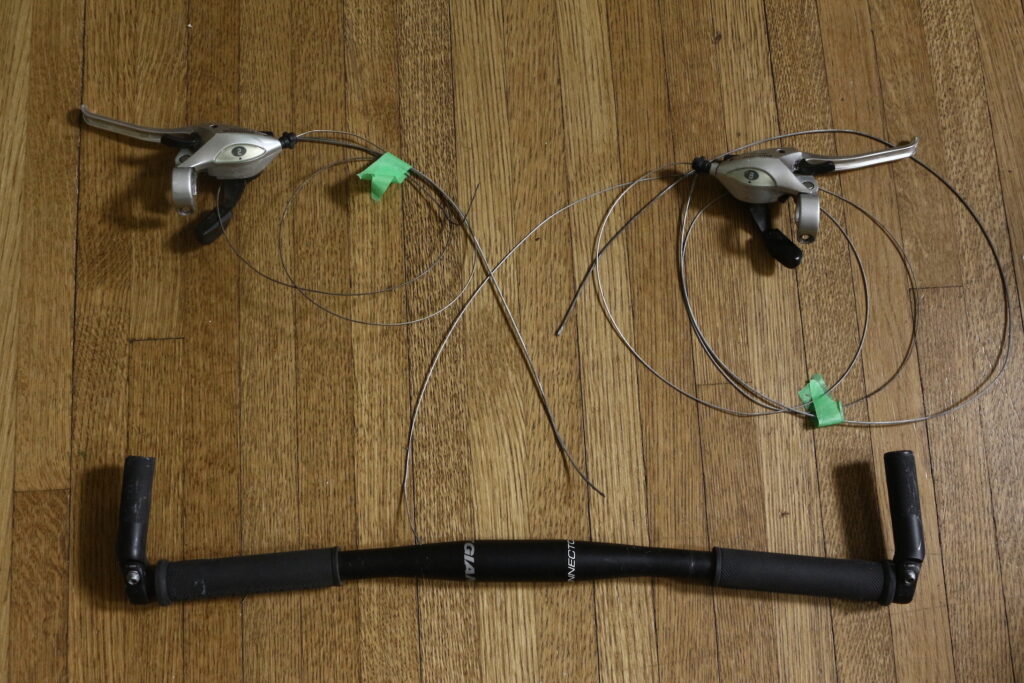
Converting a Hybrid Bike to a Road Bike
Can you convert a hybrid bike to a road bike? Yes, you can. Will it perform like an expensive road bike? Maybe, but probably not. But for most people, that’s probably fine.
This post outlines the conversion of a 2010 Giant Rapid 3 hybrid bike into a “road bike”. Fortunately, the Rapid frame geometry is almost identical to the Giant Defy endurance road bike’s geometry, so this hybrid bike is well-suited to this type of a conversion. Not all hybrid bikes may work as well as the Rapid—which was originally marketed as more of a “road bike hybrid” compared with other hybrids that lean more towards mountain bike styles.
Swapping Hybrid Components for Road Components
In order to make the hybrid bike feel more like a road bike, these were the components that I changed on the Rapid:
- Handlebars
- I replaced the stock, flat handlebars with drop-bars.
- Grips
- Drop-bars require bar tape instead of the stock flat bar grips, which do not make sense on drop-bars.
- Pedals
- Road-style pedals instead of flat pedals. This is an optional upgrade overall, but I found it to be worth it (I bought basic Shimano SPD clipless pedals).
- Brakes & Shifters, Cables
- Brake levers and shifters are the biggest changes you need to make for this type of a conversion. The new shifters and brake style will need to match the current gear set on the hybrid bike if you do not want to spend a lot of money replacing all of the gearing components. In this case, the Rapid 3 came with a Shimano 3×8 setup that is still a fairly similar gearing range to a road bike. Two options for me were cheap Amazon shifters, the MicroNew 3x8s, or new Shimano Claris 3×8 levers, which are still in production. I ended up buying both due to an error with shipping, but in the end I used the Shimano Claris levers.
- Tires – I went back to narrower tires, 700 x 28c Vittoria Zaffiro road tires (down from 700 x 32c Panaracers). This bike originally came with 28c tires which felt more “road-ish” before I upgraded to some larger 32s for light gravel riding.


The Costs of Parts Needed for this Conversion
Many of the parts required for this type of a conversion can be readily found in second-hand markets. I attempted to do this conversion as cheaply as possible while still making the bike enjoyable to ride. However some components, like new shifters, are difficult to find used based on the exact specs required, depending on the bike’s original gearing setup (prices quoted in CAD).
- Giant Connect road drop handlebars – $25 (used)
- Bontrager handlebar tape – $25 (new)
- Vittoria Zaffiro Tires & Evo Tubes – $100 (new)
- MicroNew 3×8 Brakes & Shifters, cables – $90 (new), or Shimano Claris – $220 (new)
Major Differences Between a Converted Hybrid Bike and a “Real” Road Bike
Once all of the above parts had been swapped out, there were still a couple major notable differences between the Rapid and other purpose-built road bikes:
- Gearing
- Modern road & gravel bikes are usually equipped with 2x or even 1x chain ring setups on the front, whereas many hybrids have a 3rd chain ring and wider cassette range, like a mountain bike (3x setups were common on road bikes many years ago as well, but have since fallen out of fashion). This extra chain ring adds weight to the bike, but in my opinion it’s still nice to have for tough climbs; same goes for the wider-ranging cassette.
- Wheels
- The original wheels on the Rapid 3 are heavy. Most more expensive road bikes would have lighter wheels with different spoke setups to improve aerodynamics and reduce weight. However, the Giant SR-2 wheels that came on the Rapid can take as narrow as 25c tires without issue, so to save money I did not bother upgrading them.
- Geometry
- This is probably the biggest difference; because hybrid bikes are generally manufactured with geometry that has the rider sitting in a more upright position, it’s difficult to get this kind of bike to match the angles and geometry of a similarly sized road bike. On the Rapid, I flipped my stem upside-down and lowered it as much as I could to get myself into more of a “road bike” position.
Overall Summary
This was a fun conversion project and it helped me become more comfortable with swapping components and cables on bikes. I spent more overall than I had originally intended—due to some shipping issues with the original MicroNew shifters I ordered, I opted to buy more expensive, new Shimano Claris 3×8 shifters, which are very good. I can definitely ride the Rapid much faster now that it has drop-bars, and I think it’s actually become more comfortable in this configuration for city riding than the flat bar setup, but that might just be due to my personal preference for drops.
The 3×8 Shimano Claris shifters I used for this project fit perfectly to the original groupset Giant shipped on the Rapid 3, which was also by Shimano. The bike shifts fine with the new Claris levers, and I did not have any mechanical conflicts or problems putting this setup together.
If you are on a tight budget and just want the drop-bar experience for city riding, this type of conversion is the cheapest way to go, unless you can find a good deal on an old road bike. There are many cheap road bikes out there, but at the price you would spend on this type of conversion, you would probably have to spend additional money on a used bike for the same price after buying it to upgrade worn out parts (tires, brake pads, etc.)
Pros & Cons of a Hybrid-to-Road Conversion
Pros:
- Much cheaper than buying a modern road bike, especially if buying all pre-owned components for the conversion.
- Drop-bars and narrower tires feel faster, and it most cases, are faster.
- Improved bike maintenance skills.
- Good option for use as a cheap, indoor training bike for winter.
- Likely an improved setup for long-distance biking and touring, due to improved comfort and better aerodynamics (I have not toured on this setup yet, but I suspect this to be the case).
- Hybrid bikes have lots of tire clearance and basic rack mounts; this bike can easily double as a basic “gravel bike” as it can probably take up to 37c tires.
Cons:
- Hybrid frame geometry will never quite feel the same as a more aggressive, race-style road bike.
- Finding the right parts on the used market, especially shifters/brake levers to match your existing groupset, can be a challenge.
- New shifters are expensive.
- Depending on the age of the bike, the derailleurs might be better off being replaced with newer, used road derailleurs.
Tips Before You Begin
If you want to do a similar conversion for an old hybrid bike lying around, here are some tips I would have wished I knew before I embarked on this project:
- Clean your bike well before you begin if it is old and dirty; specifically with a degreaser on the chain, chain rings, and cassette.
- Make sure you get new cables and cut the lengths appropriately before you begin—make sure you have enough slack between the headset cable mounting points and the levers when the handlebars are turned all the way to either side, otherwise you will get some “pull” on the cables and they will pull through your bar-tape and restrict your turning radius.
- Do not bother trying to shove the flat-bar levers on drop-bars to save money; I did this temporarily and almost broke the original levers, and it is completely impractical to ride a bike this way, especially on busy roads.
- Tape the cables underneath the handlebars before you put the bar-tape on, so they stay in the place you want them to be while you wrap the bar-tape on.
- Have some sort of stand set the rear wheel off the ground on while you are re-calibrating the derailleurs (a bike trainer also works).
- Clean your brake calipers if you have rim brakes, before you set the cables. If you have old and sticky calipers it’s easy to set the cable tension for the brakes incorrectly. Make sure your calipers “snap back” enough with appropriate tension and that the springs still work well; if not you will get some slack in the brake cables and braking will feel off with the road levers, like it is “skipping” before you get enough tension for the brakes to engage.
Final Product (Photos)





